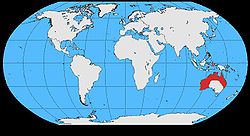- Torresian Crow
-
- '"Australian Crow" redirects here. For the butterfly, see Euploea core.
Torresian Crow 
Conservation status Scientific classification Kingdom: Animalia Phylum: Chordata Class: Aves Order: Passeriformes Family: Corvidae Genus: Corvus Species: C. orru Binomial name Corvus orru
Bonaparte, 1850
The Torresian Crow (Corvus orru), also occasionally called the Australian Crow or Papuan Crow in those respective countries, is an Australasian member of the crow genus. An all black crow, it is found in the north and west of Australia and islands to the north.
Contents
Taxonomy
The Torresian Crow was described by ornithologist Charles Lucien Bonaparte in 1850,[1] with the Australian subspecies ceciliae described by Mathews in 1912.[2] In Central Australia southwest of Alice Springs, the Pitjantjatjara term for race ceciliae is kaanka. The term wati kaanka refers to a light-fingered man or someone who hangs around suspiciously.[3]
Description
The Torresian Crow is about the same size (50–55 cm in length) as the Eurasian Carrion Crow but with a more robust bill and slightly longer legs. It has the typical white iris of the other Australasian Corvus species but can be distinguished from most (except the Little Crow) by the base of the head and neck feathers being snow white (revealed when blown by a strong wind). It also shuffles its wings after alighting.
Distribution and habitat
The range of the mainland Australian race C. orru ceciliae occupies the tropical north of Australia as far south as Brisbane on the east coast where the species seems to be adjusting well to a city life. Over much of this range, it is simple to distinguish from other species, as it is the only corvid found in northern Australia.
The other three races occur on various islands to the north: C. orru orru (the nominate form from Papua New Guinea and the Moluccas), C. orru insularis from New Britain and nearby islands and lastly C. orru latirostris of Tenimber and Barbar Islands.
The Australian Crow is not to be confused with the Australian Raven[4], which has an almost identical appearance. Despite their visual similarities, the Australian Raven and Crow (Corvus orro) have very different and unique calls.
Behaviour
Diet
A typical crow in that it will take just about anything. It has been seen taking stranded fish on the seashore, carrion, human food scraps, fruit and insects. Adaptable and intelligent like its North American, European, African and Asian relatives, it has learned how to kill and eat the introduced poisonous Cane Toad without ingesting the poison by flipping it onto its back and delivering a lethal blow with its powerful bill. It will also pick on skin parasites off of the Australian Banteng (a relationship that took around 150 years to develop).
Nesting
Two to four eggs in large stick nest high in a tree.
Voice
Quite different from the Australian Raven. A nasal "uk-uk-uk-uk-uk" or sometimes an "ok-ok-ok-ok".
Sound Link
- Torresian Crow call (Real Player)
References
- ^ Bonaparte, C.L. (1850). Conspectus Generum Avium. Tom. I. Lugduni, Batavorum: E.J. Brill 543 pp. [385]
- ^ Mathews, G.M. (1912). A Reference-List to the Birds of Australia. Novit. Zool. 18: 171-455 [442]
- ^ Cliff Goddard (1992). Pitjantjatjara/Yankunytjatjara To English Dictionary (2 ed.). Alice Springs, Northern Territory: Institute for Aboriginal Development. pp. 26. ISBN 0-949659-64-9.
- ^ australian raven
- BirdLife International (2004). Corvus orru. 2006. IUCN Red List of Threatened Species. IUCN 2006. www.iucnredlist.org. Retrieved on 5 May 2006.
External links
- Photo of Torresian Crow by water
- Photo of Torresian Crow walking on lawn
- Urban bird walking on pavement
- Torresian Crow series
Extant species of family Corvidae Kingdom: Animalia · Phylum: Chordata · Class: Aves · Subclass: Neornithes · Superorder: Neognathae · Order: PasseriformesFamily Corvidae Choughs Treepies PlatysmurusTemnurusOriental
magpiesOld World jays PtilostomusStresemann's
BushcrowZavattariornis
Categories:- IUCN Red List least concern species
- Corvus
- Birds of South Australia
- Birds of Western Australia
Wikimedia Foundation. 2010.
Look at other dictionaries:
Torresian crow — australinė varna statusas T sritis zoologija | vardynas atitikmenys: lot. Corvus orru angl. Torresian crow vok. Salvadorikrähe, f rus. австралийский ворон, m pranc. corbeau de Torres, m ryšiai: platesnis terminas – varnos … Paukščių pavadinimų žodynas
Crow — For other uses, see Crow (disambiguation). Crow American Crow (Corvus brachyrhynchos) Scientific classification Kingdom … Wikipedia
crow — I. /kroʊ / (say kroh) noun 1. either of two large, lustrous black Australian birds of the genus Corvus, having a characteristic harsh staccato call and shorter neck feathers than the raven: a. the Torresian crow, C. orru, found in Indonesia, New… …
Little Crow (bird) — Little Crow Conservation status Least Concern ( … Wikipedia
White-billed Crow — Conservation status Least Concern ( … Wikipedia
Hooded Crow — In Kiev, Ukraine Scientific classification Kingdom: Animalia … Wikipedia
American Crow — American Crow … Wikipedia
Fish Crow — Conservation status Least Concern (IUCN 3.1 … Wikipedia
Jungle Crow — C. m. culminatus, West Bengal, India Conservation status … Wikipedia
Carrion Crow — Conservation status Least Concern& … Wikipedia

